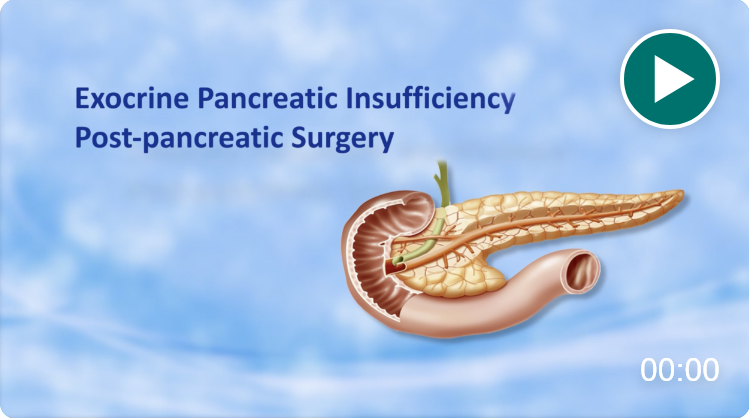
EPI Education
Take a deep dive into EPI and learn from experts in the field.
About EPI: EPI pathogenesis, symptoms, and diagnosis
Etiologies of EPI: Recognize EPI and the barriers to diagnosis
Management of EPI: Key information for managing EPI
Case Studies: Experts present case-based narratives on EPI
Select one or more filters below to explore topic-specific resources.
Transcript
The pancreas is a dual-functioning organ composed of endocrine and exocrine portions that carry out essential roles in the body. The endocrine pancreas regulates blood glucose levels. The endocrine pancreas is composed of islets of Langerhans that release hormones such as insulin and glucagon into the bloodstream. The exocrine pancreas regulates food digestion. The exocrine pancreas is composed of acinar cells that secrete digestive enzymes, and duct cells that secrete a bicarbonate buffer. Together, these secretions are known as the pancreatic juice.
This pancreatic juice plays a pivotal role in the digestion of nutrients. Pancreatic secretions are triggered when acidic chyme from the stomach enters the duodenum, releasing the hormones cholecystokinin, CCK, and secretin. Secretin stimulates secretion of bicarbonate from duct cells, and CCK stimulates secretion of digestive enzymes from acinar cells.
The main digestive enzymes secreted by the pancreas include amylases, lipases, and proteases. These enzymes are responsible for majority of digestion occurring within the small intestine. The bicarbonate solution guides enzyme transport through the pancreatic ducts for delivery to the duodenum where it neutralizes the acidic chyme and creates an alkaline environment needed for enzyme function. Appropriate timing, delivery, and mixing of chyme and pancreatic secretions in the duodenum is essential for proper digestion and absorption of nutrients.
Exocrine pancreatic insufficiency or EPI is the reduction in pancreatic enzyme production, delivery, or activity to a level below the threshold required to maintain normal digestion. EPI results in impaired digestion and decreased absorption of nutrients.
Due to the inability to digest food, patients with EPI present with a wide spectrum of signs and symptoms including flatulence, bloating, abdominal pain, diarrhea, steatorrhea, nutritional deficiencies, and unintentional weight loss.
EPI can often go unrecognized as signs and symptoms are similar to other gastrointestinal disorders. EPI occurs in conditions that lead to reduction in pancreatic enzyme production. Such reduction results from loss of pancreatic tissue such as in cystic fibrosis, chronic pancreatitis, pancreatectomy, pancreatic cancer, or necrotizing acute pancreatitis. Decreased endogenous stimulation of the pancreas may also result in reduced pancreatic enzyme production as observed in enteropathies such as celiac disease and Crohn's disease.
EPI also occurs in conditions that lead to reduction and pancreatic enzyme delivery into the duodenum. Such reduction results from obstruction of the pancreatic duct such as in calcified chronic pancreatitis, pancreatic ductal adenocarcinoma, periampullary cancer, or cholangiocarcinoma.
EPI also occurs in conditions that lead to reduction in pancreatic enzyme activity. Such reduction results from asynchrony between gastric emptying of nutrients and pancreatic enzyme secretion due to anatomical reconstruction such as in gastric, duodenal, or pancreatic surgery. Reduction in activity might also result from inactivation of pancreatic enzymes by an acidic pH, such as in gastrinomas, Zollinger-Ellison syndrome. If left untreated, patients with EPI develop nutrient and fat-soluble vitamin deficiencies, which can lead to malnutrition and its resulting consequences.
The exocrine pancreas plays a pivotal role in the digestion and absorption of nutrients. Under normal physiologic conditions, the exocrine pancreas delivers a mixture of digestive enzymes, and alkaline solution into the duodenum, which enables proper digestion of nutrients.
EPI is defined as the reduction in pancreatic enzyme production, delivery, or activity to a level below the threshold required to maintain normal digestion. EPI results in impaired digestion and decreased absorption of nutrients. Symptoms of are non-specific. A high index of clinical suspicion is required to make a correct diagnosis. If left untreated, EPI can result in vitamin deficiencies and malnutrition.
Explore EPI
Take an immersive journey into the physiology of the exocrine pancreas and the pathophysiology of EPI.
Take an immersive journey into the physiology of the exocrine pancreas and the pathophysiology of EPI.

















